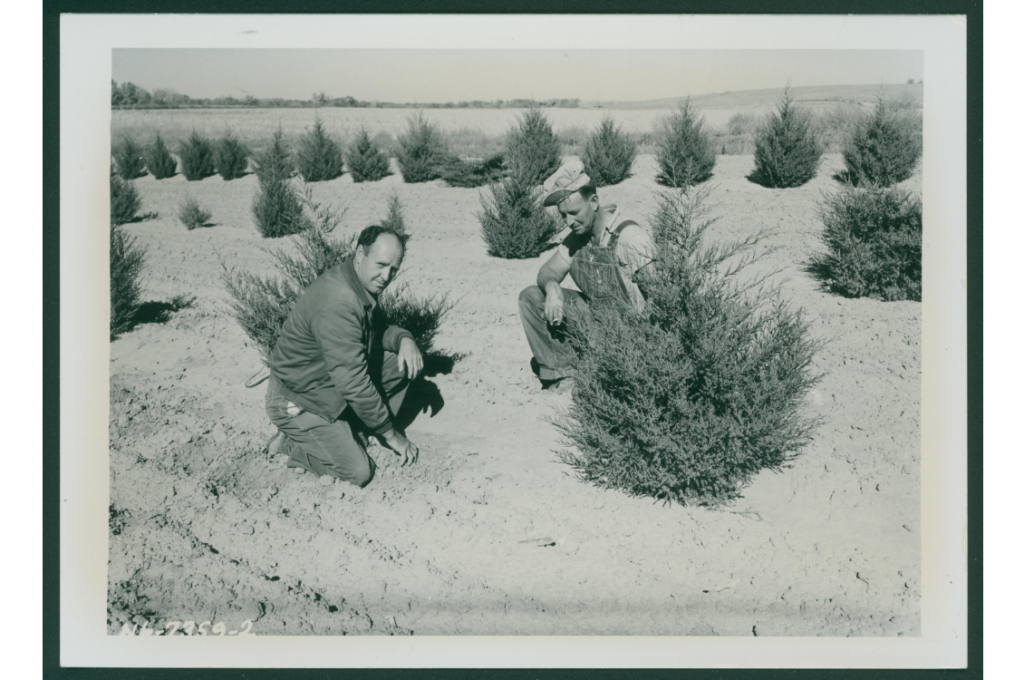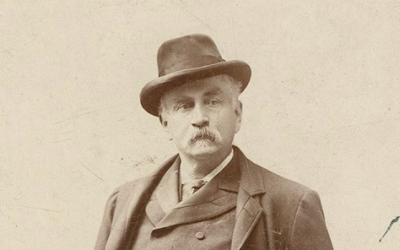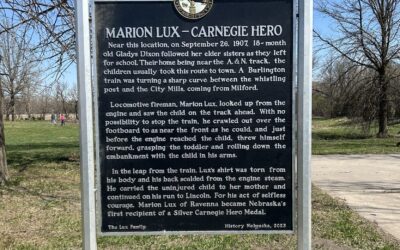In Nebraska the site of a Shelterbelt, also known as a windbreak, is common for those traveling across the state. These lines of trees are designed to protect fields and farms from the harsh winds that sometimes sweep across the plains. However, many probably do not know the history of why Nebraska has so many of these Shelterbelts.

Black and white photograph of two men examining trees planted in Red Willow County, Neb. (NSHS RG2570.PH)
Some 19th century Nebraska leaders encouraged farmers to plant trees; J. Sterling Morton proposed Arbor Day for this purpose. During the droughts of the late 1920s into the 1930s, farmers were affected by dust storms which picked up large quantities of top soil, destroying the productivity of land. To help prevent this, some people, such as Senator George Norris, advocated for the planting of trees to slow down or prevent erosion. President Franklin D. Roosevelt signed an executive order creating the Shelterbelt Project in 1935. The first shelterbelt planted in Nebraska was on April 4, 1935 near McCook in Red Willow County.
Congress in 1937 passed the Norris-Doxey Cooperative Farm Forestry Act. George Norris was a co-sponsor. The project was renamed the Prairie State Forestry Project after the legislation was passed. The work of planting the trees was coordinated by the U.S. Forestry Service and done in conjunction with the Works Projects Administration and the Civilian Conservation Corps. During the eight-year life of the project, over 4,000 miles of windbreaks were planted across Nebraska. If you lined up that windbreak it would wrap around Nebraska more than twice. Nebraska had 500 more miles of shelterbelts than any other state participating in the project.
Many of the Shelterbelts you see are not the originals from the 1930s. Many of the trees have gotten too old and had to be removed. Shelterbelts also have been removed due to farmers wanting to use that extra bit of land to plant more crops or to provide room for center pivot irrigation. However, you can still see the impact of those original shelter belts on Nebraska today.
If you would like to see pictures from the shelterbelt project, click here. To learn more about the history of Shelterbelts and why people advocated for them, check out the 1976 Nebraska History Magazine Article “Shelter Belts in Nebraska” (PDF) by Richard Lowitt. The Nebraska State Historical Society also has a collection of correspondence, manuscripts, articles, and other records of Paul Henley Roberts (RG3941.AM), who worked on Shelterbelt plantings during part of his career at the U.S. Forest Service. To view this collection, contact our research services.
– Christian Newth, Membership and Volunteer Coordinator NSHS, April 2025
Sources:
Richard Lowitt, “Shelterbelts in Nebraska,” Nebraska History 57 (1976): 405-422. Accessed at: https://history.nebraska.gov/wp-content/uploads/2017/12/doc_publications_NH1976Shelterbelts.pdf
Gary L. Hergenrader, “The Shelterbelt Project in Nebraska”, National Museum of Forest Service History Newsletter, August 2008, Volume 20 No. 3. Accessed at: https://forestservicemuseum.org/wp-content/uploads/2020/10/NMFSH_newsletter_aug_2008.pdf
Paul Henley Roberts, Paul Henley Roberts Collection, RG3941.AM, Nebraska State Historical Society, Finding Aid: https://history.nebraska.gov/collection_section/paul-henley-roberts-1891-1971-rg3941-am/.




